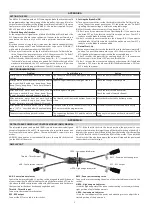
20
21
Reverse Take off
Thermals and Soaring
The preparation is the same as to forward take off. But this time you have to turn towards
the canopy. During the turn lift the hand which is turning away from the glider with the
risers above your head. Now you can inflate the glider with the red A risers. Push the
risers up and let them go when the canopy is over your head. If necessary use the brakes
gently. Turn out and begin the start run. Attention: check to turn out to the right side.
Example you turned with your left side to the glider you have to turn out with your left
side to the glider. Otherwise you will have made a 360 degree turn and all your risers are
twisted.
In case of strong wind it could be necessary to make some steps towards the canopy
during inflation. This take off method can be used even with little wind.
In turbulent conditions, the paraglider must be flown with the brakes softly applied,
resulting in greater canopy stability. The pendulum effect back and forth must be
avoided! The canopy must remain on top of the pilot. For this purpose, the speed must be
increased by releasing the brakes upon entering a thermal (depending on its intensity) or
braking on exit. This is part of the basic technique on “active flying”.
During soaring, a minimum height of 50m over ground is highly recommended, for safety
reasons. Knowing and respecting flight regulations is extremely important, especially
when airspace within close proximities of mountains is shared among several pilots,
where last minute anti-collision maneuvers are not executable.
Turns
Accelerated flight
The Prymus 5 is very sensitive, responding instantly to turn commands. Leveled turns
can be achieved with the shifting of weight on the risers with minimum altitude loss.
A combination of weight shifting and breaking technique is the most efficient way of
executing turns in any situation. The given brake utilized determines the radius of turns.
By activating the brakes on the outside edge of the turns, as well as applying maximum
weight shifting on the risers, the efficiency and resistance to collapse in turbulences (at
the edge of thermals) is increased.
In case it becomes necessary to perform turns in a constrained space we recommend to
release the outside brake in the given turn and pull a little more the brake on the inside
of the turn.
The paraglider glides best when no brakes are applied.
It is recommended to use the accelerator when flying against the wind or in zones with
descending air. Due to a decreased angle of attack, the canopy may collapse easier than
when set at the normal position. The pilot must remember that the higher the speed, the
more dynamic the collapse response or symmetric closing will be.
- Exercise the use of the accelerator during calm conditions.
- Be cautious flying accelerated in difficult and turbulent conditions.
- Remember: The higher the speed the higher the descent rate.
- Check always on all accelerator parts for good function and signs of wear.
By pulling either brake too strongly or suddenly, there is a danger of creating a
negative spiral!
Active flying
For best performance during your flight, it is important to be always sensitive to what
your canopy is trying to communicate. The key elements of active flying are: controlling
the canopy advancement and the canopy pressure. If you apply gently the brakes (about
+- 15cm) you are getting a good feedback about the canopy pressure, which can alter
easily in turbulent air. You can feel it very well on the brakes. The general idea: keep the
pressure constant.
Avoid flying excessively with the brakes on, cause you might brake to the point of stopping
the canopy from flying. Always consider your aerodynamic speed. Your movements can
be symmetric or asymmetric and both or one brake can be applied. This corrections
control your flight and reduce the risk of collapses. We suggest that you practice on the
ground. Canopy advancement and pressure loss can be simulated well on the ground.
Содержание Prymus 5
Страница 1: ...Manual LTF EN A Version 1 12 2018 ...












































